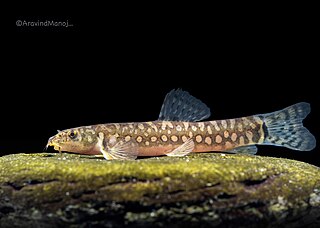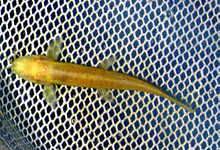The Starostin's loach is a species of troglobitic stone loach endemic to Turkmenistan. It is the only known member of the genus Troglocobitis, but it has previously been included in the genus Nemacheilus. It is the only cavefish known from Central Asia. The species English vernacular name and specific name honour the hydrobiologist I. V. Starostin, who was a researcher of the inland waters of Turkmenistan.
Schistura oedipus is a species of troglobitic stone loach endemic to caves in the Pang Mapha karst formation in Mae Hongson Province in Thailand. It is only found in very fast flowing cave streams where it feeds on micro-organism and organic matter. This species is highly sensitive to disturbance, changes in water quality and hydrography. The specific name oedipus refers to the mythical Ancient Greek king of Thebes, Oedipus who tore out his own eyes, this species has degenerate eyes.
Yunnanilus macrogaster is a hypogean species of stone loach endemic to China. This species is endemic to the endorheic drainage system which feeds the Datangzi Marsh in Luoping County, Yunnan, the marsh has been formed by the outflow of a stream from its underground course. It is a demersal species and the waters where it was found were densely vegetated, it feeds on worms and insects. It is sympatric with Yunnanilus niger and Y, paludosus, forming a small species flock. It lays eggs which it does not guard.

The Mexican blind brotula is a species of viviparous brotula endemic to Mexico, where it is found in sinkholes and caves. It is known as sak kay in Mayan and dama blanca ciega in Spanish. This cavefish grows to a standard length of 9.7 cm (3.8 in). It is the only known member of its genus.

Barilius evezardi is a fish in genus Barilius of the family Cyprinidae. It is found in Maharashtra of India, specifically in the upper reaches of rivers on hills.
Schistura deansmarti is a species of ray-finned fish in the stone loach genus Schistura. It is found in cave streams in a karst landscape in the Thung Salaeng Luang National Park of Phitsanulok Province where it lives mainly on the stream beds and feeds on organic material and micro-organisms. The specific name honors the British speleologist who collected the original specimens and who works for the conservation of caves in Thailand.
Oxynoemacheilus evreni is a species of freshwater fish in the genus Oxynoemacheilus, belonging to the order Cypriniformes. It is widely distributed and locally abundant within the Ceyhan drainage, where it inhabits streams and rivers with gravel substrate and fast to very fast currents. Although, its population may have experienced a slight decline due to dam construction, the species has shown tolerance to some human-altered habitats.
Schistura kaysonei, the Laotian cave loach, is a species of ray-finned fish in the genus Schistura. It is endemic to Laos where only found in streams in caves. Like other cave-adapted fish, it is blind and has little pigmentation. This troglobitic species has been recorded from only a single cave in a karst landscape in Khammouane Province in Laos. Here it can be found around 100m from the cave entrance and its diet is thought to be organic detritus, such as bat guano, and micro-organisms. It is threatened by a decline in the quality and quantity of the water flowing through the case, caused by deforestation and increased agriculture, as well as potential overfishing for the aquarium trade. The specific name honours Kaysone Phomvihane (1920-1992), who was president of Laos.
Schistura papulifera is a critically endangered species of ray-finned fish, a troblobitic stone loach, in the genus Schistura endemic to the state of Meghalaya in India. It is currently known to be restricted to the Krem Synrang Pamiang cave system near the Jaintia Hills, where it is threatened by limestone extraction. This species lives in pools of standing water within the cave system preferring these to the streams of flowing water, being most numerous in the largest and deepest pools. This may be because the larger pools offer a more stable environment for the fish. The specific name is a compound of the Latin papula meaning "a small tumour" and fera meaning "to bear", referring to the growths around the lower half this species head.
Schistura spekuli is a species of ray-finned fish, a troglobitic stone loach, in the genus Schistura. It has been recorded from a single cave in central Vietnam. The specific name refers to SPEKUL, the speleological club of the University of Leuven in Belgium.

Schistura waltoni is a species of ray-finned fish, a stone loach, in the genus Schistura. It is a species of in streams which have a moderate to fast current where it can be found in riffles, over gravel to rock beds. It is often recorded in small streams in forest, even where the water is very shallow. It occurs in the upper reaches the Chao Phraya watershed in Thailand in the rivers Mae Nam Ping, Mae Nam Wang and Mae Nam Yom. The specific name honours Joseph Walton a 19th Century contributor to the fish collection at the Academy of Natural Sciences of Philadelphia.
Oxynoemacheilus hamwii, the Orontes sportive loach, is a species of ray-finned fish in the genus Oxynoemacheilus. This species is found in the headwaters of the Orontes River but is now restricted to three streams in the Turkish part of the drainage, two joining the lower Orontes in Turket and the third flowing into the Afrin River in Syria, and has been extirpated from Syria. It was described as being very common in the late 20th century, but it is sensitive to pollution and requires clear, flowing streams over mud or gravel. The drainage of the Orontes is heavily used by humans and lower rainfall in the region caused by climate change may exacerbate the threat to this species by increasing the amount of water taken from the streams by humans and by lowering the water table.
Oxynoemacheilus theophilii is a species of stone loach native to Turkey and the island of Lesbos in Greece. This species occurs in streams and reaches a length of 6.6 centimetres (2.6 in) SL. It is found in the Büyük Menderes River and other streams in western Anatolia, Turkey, and the Evergetoulas Stream on the island of Lesbos, Greece. It can be found in the upper reaches of streams with clear, cold, flowing water where it hides among the stones of the stream bed. The stomach contents of a single female were found to consist of aquatic insect larvae. Water abstraction and the increased droughts caused by climate change are the main threats.
Oxynoemacheilus bergianus, the Kura sportive loach, is a species of ray-finned fish in the genus Oxynoemacheilus. This species is found in Lake Urumiyeh and Namak Lake basins in Iran, in the southern Caspian basin from Kura east to the Sefid-Rud drainage. It can also be found in the headwaters of Tigris in Turkey, Iraq and in Karoun, Iran as well as those of the Euphrates in Turkey and possibly in Syria and Iraq. It lives in fast flowing streams and rivers with gravel and rocky substrates and does not tolerate impoundments, dam construction having been identified as a major potential threat to this species.

The Tibetan stone loach is a species of ray-finned fish in the family Nemacheilidae. The specific name is sometimes spelled stoliczkae but the original spelling used by Steindachner is stoličkai. It is found in southern and central Asia.

Mesonoemacheilus herrei is a critically endangered fish described by Teodor T. Nalbant and Banarescu in 1982. It is endemic to India and is currently only recorded within the Indira Gandhi Wildlife Sanctuary and National Park in Tamil Nadu.

Kotumsar cave is a limestone cave located near Jagdalpur in the Indian state of Chhattisgarh. Kotumsar cave is a major attraction for people interested in ecotourism. It was initially named Gopansar cave but the present name Kotumsar became more popular as the cave is located near a village named ‘Kotumsar’. Kotumsar cave formed on the Kanger limestone belt, situated near the bank of the River Kanger, a tributary of the Kolab River.
Oxynoemacheilus atili, the Lake Beyşehir loach, is a species of stone loach from the genus Oxynoemacheilus. It is endemic to Turkey being found only in the drainage basin of Lake Beyşehir in Central Anatolia, where it occurs in all the streams and in the Manavgat drainage in Mediterranean basin.
Pterocryptis burmanensis is a species of catfish found in the Indo-China peninsula.
Pterocryptis gangelica is a species of catfish found in the Ganges River, where it occurs in India and Bangladesh.







